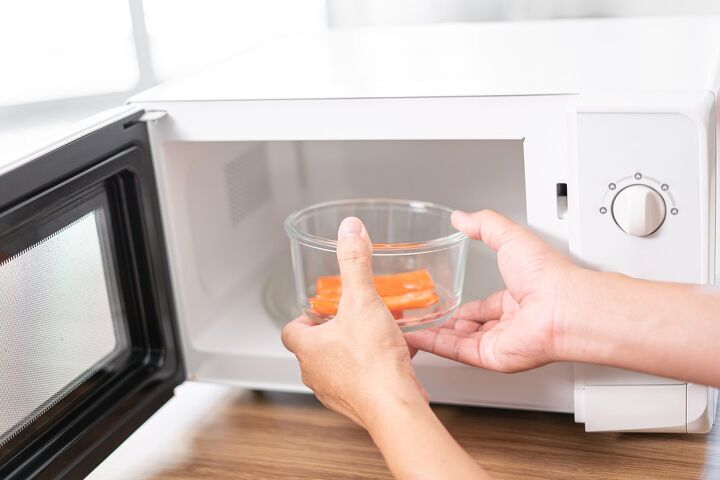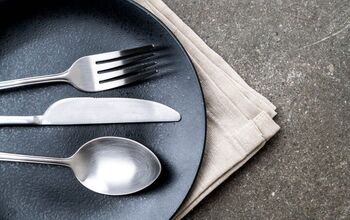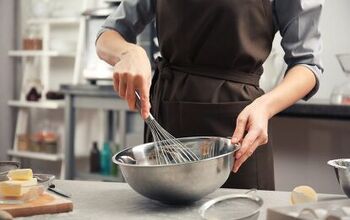Can You Put Glass In The Microwave? (Find Out Now!)

For a lot of people, cooking can be a complicated process- but it doesn’t have to be! Knowing what materials are suitable for which cooking environments is essential. For example, can you put glass in the microwave?
Glass can be put in the microwave if it doesn’t have metal detailing and is without the rubber top. To avoid thermal shock and cracking, make sure your glass container is at room temperature first. Place your microwave on a ‘medium’ power setting and use 2-minute intervals to safely warm your food.
Never use your glassware on the stovetop, as uneven temperatures will cause the glass to shatter.
In this article, we’ll discuss whether or not putting glass in the microwave is safe, if you can put glass in the oven, and if glass is appropriate for use on the stove.
Is It Safe to Put Glass in the Microwave?
Using a microwave can be a quick way to reheat last night’s leftovers. While we know aluminum can’t be used inside the microwave, what about glass?
Glass can be used in the microwave as long as there aren’t any metal design details on the container you’re using. Additionally, you want to make sure to remove rubber tops.
Metal aspects of a glass container will spark and create a fire hazard, while rubber may melt at higher temperatures. Another interesting finding is that microwaving cold glass containers can be dangerous.
Cold items shrink while hot items expand. It’s because of this rule that small air bubbles trapped in a cold glass container may cause the bowl or plate to shatter when heated too quickly.
Most glass kitchenware will read “Microwave-Safe” on the bottom if it can be used in the microwave.
How to Microwave Glass
If you’re unsure if your glass item is microwave-safe, there’s a test you can run.
To test glass in the microwave:
- Fill up a microwave-safe cup halfway with water.
- Put the glass container in the microwave with the cup of water.
- Run the microwave on ‘medium’ power for 15 seconds.
If there’s no spark, reaction, and the container is not extremely hot when you remove it, your glass item is safe to use!
Now that you know your glass container can be warmed in the microwave, what’s the best practice for doing so?
- Make sure your glass container is room temperature (NOT cold) and without metal accents.
- Put the glass container, with food, in the microwave with a paper towel on top to limit mess.
- Set your microwave to ‘medium’ power and run it on cycles of 2 minutes or less, or until your food is at the desired temperature.
- When you remove the food, place the glass cookware on a towel or pad instead of your cold countertop.
Even if your counters are durable and made of something like granite, you don’t want the glass item to shatter as a result of drastically different temperatures.
How Can You Tell if Glass Is Microwave-Safe?
There are a few ways to determine if your glass bowl, plate, or cup is able to be used in the microwave.
The most obvious way is by looking for a “Microwave-Safe” label. If you don’t see one, you could always use the testing steps mentioned above. Check the temperature of your glassware immediately after- it should not be hotter than the food inside.
Additionally, look for any metal components. Glass items without them are generally safe to use in the microwave.
Can You Put Glass in the Oven?
Most glass containers that are microwave-safe are also able to be used in the oven. However, you should avoid using small items like bowls, plates, or cups inside.
Larger glass cooking containers are specifically made for the oven. They’re great for lasagna, layered brownies, and other thick dishes. Generally, glass containers can withstand up to 425 degrees Fahrenheit in a traditional oven setting.
To avoid thermal shock, make sure your glass cookware is room temperature before placing it inside the oven!
Why Use Glass Instead of Metal in the Oven?
There are several reasons why glass is a better option than metal for use in the oven.
For starters, glass isn’t reactive and doesn’t absorb flavoring from previous dishes as metal does. It also does a much better job holding heat and keeping your dish warm after it’s removed from the oven.
Glass takes a little bit longer to heat up, so it will also limit the chances of your food burning or becoming dry quickly.
Can You Put Glass on the Stove?
This question is a bit tricky. Although glass can be used inside the oven, it’s usually unsafe to use on a stovetop.
Your glass container will experience thermal shock when exposed to irregular temperatures. When you place glass in the oven, the entire dish is immersed in the same amount of heat. On top of a stove, the bottom of your glass cookware will expand unevenly and crack.
This is why it’s best to use metal on stovetops. Even durable brands like Pyrex will shatter if used incorrectly.
Related Questions
Is a glass coffee mug microwave-safe?
Just like glass bakeware, glass coffee mugs are usually microwave-safe. Although, it’s always good practice to look for a “Microwave Safe” label regardless.Follow the same instructions we discussed above:
- Make sure your glass cup is at room temperature before placing it in the microwave.
- Set your microwave power to ‘medium.’
- Warm your drink in 2-minute or fewer intervals until the desired temperature is reached!
Glass containers can be placed in the freezer as long as you follow specific guidelines.
The best type of glass for freezer use is borosilicate or tempered glass. Make sure your container is room temperature before putting it inside, and avoid storing hot food items before they have cooled.
When you take glass out of the freezer, if you wish to heat the components up, the container must defrost first.
Is glass recyclable?
Most glass can be recycled, although it’s difficult to do so.
Recycling glass demands a high grade of cleanliness and purity. Even the slightest speck of residual food can ruin the process. That’s why it’s important to thoroughly rinse all of your glass containers out before recycling.
Look up your county’s recycling guidelines. Some areas will allow you to recycle glass in your weekly containers, while others will require a special item pickup.
Final Thoughts
When you’re unsure about whether or not you can put glass in the microwave, the best thing to do is look for a label that explicitly says “Microwave Safe.”
You can also check your glassware and see if it contains any metal components, as food cooked in microwaves cannot come into contact with anything made of metal.
If your dish doesn’t have a “Microwave Safe” label, start by microwaving it on a ‘medium’ power setting, with a cup of water, for 15 seconds. If there is no reaction and the container doesn’t come out feeling hotter than the food inside, it’s safe to use.
While most glass containers are also oven-safe, never use them on a stovetop due to the risk of thermal shock. Always consult the manufacturer or company website to determine the safest way to microwave your glassware!

Emily is a copywriter with over five years of experience in crafting content for the home renovation and remodeling industry. She loves house projects, whether it be painting a room or tweaking small design elements to transform a space. Her favorite aesthetic is french modern because of its clean lines and airy feeling! When not writing, Emily loves to travel and check out architectural details all over the world.
More by Emily Carr



























